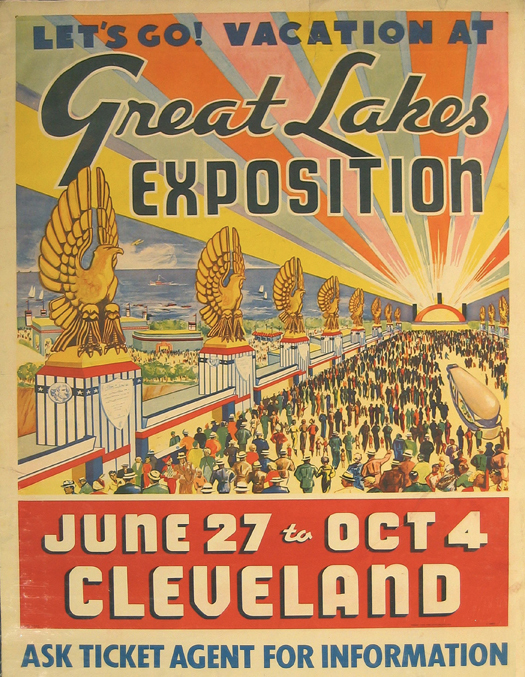
Great Lakes Exposition poster, 1936 (via Lost Wonders of Cleveland)
Did you know there was a World's Fair in Cleveland in 1936? Neither did I, much less one with an eagle-eye concourse. So fixated is design history on the New York World's Fair of 1939, with its Finnish Pavilion by Alvar Aalto and Futurama by Norman Bel Geddes, and the Chicago Century of Progress Exposition of 1933-34, with its glass House of Tomorrow by George Fred Keck that it has tended to forget the others: San Diego, Dallas, Cleveland, and San Francisco. "Designing Tomorrow: America's World's Fairs of the 1930s," an exhibition at the National Building Museum that closes July 10 rights that wrong, contextualizing the period by pointing out themes common across all the fairs, and putting on display photographs, posters, furniture, architectural models and ephemera.
Related: The New York Public Library recently released an iPad app with treasures from their 1939-40 World's Fair collection. And the Cleveland Memory Project has more on the Great Lakes Exposition. If readers know other good online image sources, please post links in the comments.
When I saw it last week, in conjunction with my talk on "Modernism for the Masses," I was particularly attracted to the architecture-themed ephemera.
Like this.

1939 World's Fair fabric (via Flickr)
The exhibition includes a dress made of fair fabric, as well as a quilt featuring the Sears building at the Chicago fair, which won a national quilting bee sponsored by the store. The fabric and quilts, with buildings where the flowers should be, nicely encapsulate two of the themes of the exhibition: home and architecture-as-advertising.
These fairs, as one of the few going construction projects during the Depression, attracted home builders and materials manufacturers, whose demonstration homes showcased innovations that wouldn't become common until the 1950s. There were moderne and modernist homes, sure, but also many that cloaked new technology in the ruling neo-Colonial style.
The exhibition also includes a wonderful visual primer of fair pavilion architecture, ranging from the shell-shape Shell pavilion (National Cash Register tried a similar approach in both Dallas and New York), to the streamlined Futurama building by Albert Kahn, to stodgier, stagier approaches.
Curators Laura Burd Schiavo and Deborah Sorensen also have a blog that has lots of extra images and detail, including film suggestions and close-up slideshows, like this one on the fairs' "eclectic modernism." The highlight may be the full-length promotional film, made by Westinghouse, "The Middleton Family at the New York World's Fair." The generation gap never yawned so wide.
